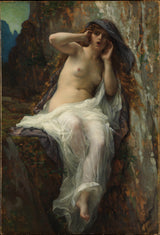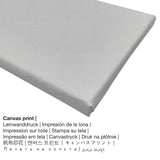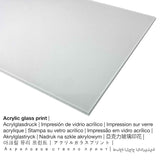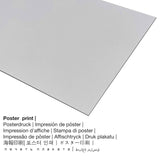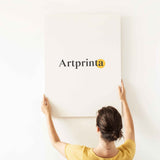Alexandre Cabanel, 1874 - Echo - mbipụta nka mara mma
Ụtụ gụnyere. Mbupu gbakọrọ na ndenye ọpụpụ.
Nṅomi ọmarịcha nka nke gị
In 1874 Alexandre Cabanel painted the realist artwork "Echo". Ụdị eserese a tụrụ nha: 38 1/2 x 26 1/4 na (97,8 x 66,7 cm). Mmanụ na kwaaji was used by the European painter as the technique for the artwork. Besides, the artwork belongs to the digital art collection of Museumlọ ihe ngosi nka nke Obodo, nke bụ otu n'ime ụlọ ngosi ihe ngosi nka kachasị ukwuu na nke kachasị mma n'ụwa, nke gụnyere ihe karịrị nde abụọ ọrụ nka na-agbaso puku afọ ise nke omenala ụwa, site na prehistory ruo ugbu a na site n'akụkụ ọ bụla nke ụwa .. Site n'ikike nke: The Metropolitan Museum of Art, New York, Gift of Mary Phelps Smith, in memory of her husband, Howard Caswell Smith, 1965 (public domain). Besides, the artpiece has the creditline: Gift of Mary Phelps Smith, in memory of her husband, Howard Caswell Smith, 1965. Further, the alignment is portrait and has a ratio of 2: 3, nke pụtara na ogologo bụ 33% mkpụmkpụ karịa obosara. The painter, university teacher Alexandre Cabanel was an artist, whose artistic style can be attributed primarily to Realism. The European painter lived for a total of 66 afọ, amuru na 1823 in Montpellier, Occitanie, France and passed away in the year 1889.
Nye iwu ihe onwunwe nke nhọrọ gị
Anyị na-enye ihe dị iche iche dị iche iche na nha maka ngwaahịa ọ bụla. Anyị na-ahapụ gị ka ịhọrọ nha na akụrụngwa ọkacha mmasị gị n'etiti nhọrọ nhazi ngwaahịa ndị a:
- Kwaaji: A canvas print, which shall not be confused with a canvas painting, is a digital replica printed on an industrial printer. It generates a extra impression of three-dimensionality. Also, a canvas print creates a homelike and enjoyable look. A canvas print has the advantage of being relatively low in weight, meaning that it is easy and straightforward to hang up the Canvas print without extra wall-mounts. That is why, canvas prints are suitable for any type of wall.
- Akwụkwọ mmado na ihe kwaaji: The Artprinta poster is a printed flat canvas paper with a slightly roughened finish on the surface, that reminds the original work of art. Please bear in mind, that depending on the size of the poster print we add a white margin 2-6cm around the print, which facilitates the framing with a custom frame.
- Aluminom dibond (ọkpụkpụ ọla): An Aluminium Dibond print is a material with a true depth. Its non-reflective surface structure make a fashionable look. This direct UV print on Aluminum Dibond is the most popular entry-level product and is a truly stylish way to display art reproductions, since it puts 100% of the viewer’s attention on the whole artwork.
- Mbipụta iko acrylic (nke nwere ezigbo mkpuchi iko): The acrylic glass print, which is often named as a print on plexiglass, will convert your favorite original artwork into beautiful décor. The great upside of an acrylic glass print is that contrasts and small artwork details become recognizeable due to the fine tonal gradation. Our acrylic glass protects your custom art replica against light and external influences for many years to come.
Disclaimer: We try everything in order to describe the products as closely as possible and to illustrate them visually in our shop. Still, the pigments of the printing material and the imprint can diverge slightly from the image on your screen. Depending on the settings of your screen and the nature of the surface, not all colors are printed 100% realistically. In view of the fact that all art prints are printed and processed manually, there may as well be minor deviations in the motif's size and exact position.
Ihe omuma
| Nkewa edemede: | ọmarịcha nka |
| Usoro mmeputakwa: | dijitalụ mmeputakwa |
| Usoro mmepụta: | UV kpọmkwem obibi |
| Ihe ngosi: | German mmepụta |
| Stockdị ngwaahịa: | a na-achọ |
| Ihe eji eme atụmatụ: | mgbidi mgbidi, ihe ndozi ụlọ |
| Ndozi onyonyo: | nhazi ihe osise |
| Njikwa oyiyi: | 2:3- (ogologo: obosara) |
| Pụtara nke akụkụ akụkụ: | ogologo bụ 33% mkpụmkpụ karịa obosara |
| Akwa ngwaahịa dị: | Mpempe akwụkwọ mmado (akwụkwọ kwaaji), mbipụta kanvas, mbipụta ọla (aluminium dibond), mbipụta iko acrylic (nwere ezigbo mkpuchi iko) |
| Nhọrọ nke akwa akwa n'elu etiti ihe ndọtị (mbipụta akwa akwa): | 20x30cm - 8x12", 40x60cm - 16x24", 60x90cm - 24x35", 80x120cm - 31x47", 100x150cm - 39x59" |
| Mbipụta iko acrylic (nke nwere ezigbo mkpuchi iko): | 20x30cm - 8x12", 40x60cm - 16x24", 60x90cm - 24x35", 80x120cm - 31x47" |
| Ụdị akwụkwọ mmado (akwụkwọ kwaaji) dị iche iche: | 40x60cm - 16x24", 60x90cm - 24x35", 80x120cm - 31x47" |
| Mbipụta aluminom (ihe alumini debond ihe): | 20x30cm - 8x12", 40x60cm - 16x24", 60x90cm - 24x35", 80x120cm - 31x47" |
| ụba: | na-enweghị etiti |
Nkọwa ọrụ nka
| Aha nka nka: | "Echo" |
| Nhazi nka: | sere |
| Otu izugbe: | nkà nke oge a |
| Century: | 19th narị afọ |
| Ekepụtara: | 1874 |
| Afọ nka: | 140 afọ |
| Agba na: | mmanụ na kwaaji |
| Akụkụ ihe osise izizi: | 38 1/2 x 26 1/4 na (97,8 x 66,7 cm) |
| Egosiputara na: | Museumlọ ihe ngosi nka nke Obodo |
| Ebe ngosi nka: | New York City, New York, Njikota Obodo Amerika |
| website: | Museumlọ ihe ngosi nka nke Obodo |
| Akwụkwọ ikike nka: | ngalaba ọha |
| Site n'aka: | The Metropolitan Museum of Art, New York, Gift of Mary Phelps Smith, in memory of her husband, Howard Caswell Smith, 1965 |
| kreditline ọrụ nka: | Gift of Mary Phelps Smith, in memory of her husband, Howard Caswell Smith, 1965 |
Ihe omuma ihe nka
| Ihe nkiri: | Alexandre Cabanel |
| Aha utu aha: | Cabanel Alexandre, Alexandre Cabanel, Cabanel Alexander, a. cabanel, alex cabanel, Cabanel |
| okike onye nka: | nwoke |
| Obodo onye nka: | French |
| Ọrụ nke onye na-ese ihe: | onye na-ese ihe, onye nkuzi mahadum |
| Country: | France |
| Otu nka: | omenkà nke oge a |
| Ụdị nka: | Ihe ngosi |
| Akwụsị: | 66 afọ |
| Afọ amụrụ: | 1823 |
| Ebe amụrụ onye: | Montpellier, Occitanie, France |
| Nwụrụ n'afọ: | 1889 |
| Ebe ọnwụ: | Paris, Ile-de-France, France |
Enwere ikike nwebiisinka ©, Artprinta.com (Artprinta)
Nkọwa ndị ọzọ sitere na The Metropolitan Museum of Art (© - Ụlọ ihe ngosi nka nke obodo ukwu - Museumlọ ihe ngosi nka nke Obodo)
In Greek mythology, the beautiful nymph Echo is cursed by the goddess Hera and can only repeat the last words said to her. Unable to communicate with the man she loves, Echo retreats to the mountains and pines away until just her voice remains. This painting depicts the nymph with her mouth agape and her hands at her ears as if startled by reverberating sounds. The mannered elegance and polished handling of the figure epitomize the style promoted by the influential French Académie des Beaux-Arts. Nineteenth-century critics often deemed such idealized portrayals of the nude unconvincing, but many viewers preferred them to more realistic depictions, which seemed shockingly indecorous.

